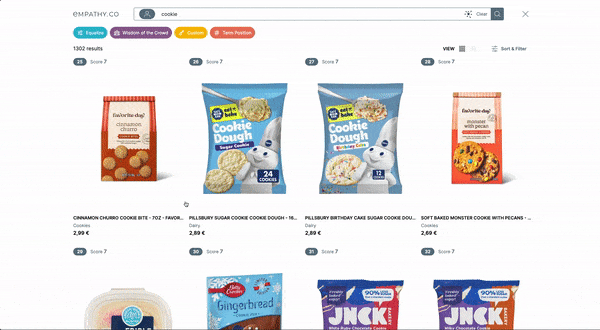Why Findability is the only real metrics that matters and why we’ve evolved how we measure it
Why Findability is the only real metrics that matters and why we’ve evolved how we measure it

When you browse on an eCommerce site, you’re perhaps unaware of the amount of information you’re generating, and the same happens when you make a query on a search engine. All your activity, from the searches to the navigation to the add to cart, generates data which is extremely useful for online retailers. What’s more, this information often forms a basis for the decisions they take to improve their site and services.
Traditionally, sites have used two main methods to measure and put KPIs against the success of search: relevancy and conversion. However, both have flaws. Relevancy doesn’t allow for user context, it`s not a constant. For example, the query “ dress ”, may offer good, valid results for one customer and yet, the very same list of results can be perceived as incorrect for another. So as there is no absolute perception for relevancy it can’t be used as a reliable or accurate measurement.
Likewise, conversion as a KPI has limitations as it doesn’t take into account the level of commitment. For example, someone who had an extremely frustrating experience may have made a purchase out of necessity and that conversion would be counted as successful. Meanwhile someone else may have had a wonderful experience and found what they were looking for but they didn’t convert because it wasn’t the time to buy, perhaps they were on the move, on the bus say, and this would be counted as an unsuccessful search visit.
We believe we need to look at this problem differently. That’s why we use the notion of Findability to measure success in search. Findability is about whether the user found what they were looking for, or whether the product was found. We do this through measuring clicks and importantly the effort required to arrive at the interaction. For example, if the click was far down the list or if a shopper had to facet that’s not good for findability. If, however it was on the first page, that’s great. Findability is the metric we use to let our eCommerce clients know how well their products are placed, or in other words, if their users are able to quickly find what they’re looking for. Always taking into account that each consumer has different intentions and expectations. Findability shifts the focus from the more conventional metrics to that which makes us have either a good or a bad experience.
As with everything we do at EmpathyBroker, we’re constantly looking to innovate and adapt to the changing needs of our customers and the evolution of eCommerce. And, while we’ve been using Findability as a metric for several years, we’re now reformulating it and how we use it to measure success.
This is primarily due to the recent changes in the way people interact with eCommerce sites. For example, previously, users were responsible for switching between different pages of search results whereas now most sites have an infinite scroll. This type of change affects the way shoppers navigate and, of course therefore, our current formula for Findability. ### Re-defining the formula for Findability The parity between a consumer query i.e. “ denim dress ” and the derived clicks are the essence of the Findability measurement. Findability is therefore more successful if the road is shorter. It provides a solid and objective base of calculous to which we’re able to benchmark key strategical design decisions and understand if customers can connect to a catalogue correctly.
Nowadays, the formula is defined by the number of clicks on the first page and the number of queries. However, after studying and statistically analysing data collected from several different clients, we ascertained that the most influential indicator within the data is still the queries and clicks but we needed to change the variables related to these terms to re-calculate the formula. Therefore, we looked at the different variables that we needed to take into account in order to introduce a new approach to the Findability formula. These are the position of the product clicked, the number of words contained in the queries, the number of total queries, the unique queries and the number of page views per query.
It’s important to note that we no longer consider the page on which the click was made, but the position of the product clicked. This, as previously mentioned, is due to the introduction of the infinite scroll which made this reformulation and new approach more necessary.
Our data team’s first approach was to develop several possible formulas, weighting the different variables according to their importance. These possibilities contained the same fundamental variables: the position of the click and the number of queries. In addition, we incorporated different combinations of the remaining variables and even included all the variables in one equation. However, due to its complexity and especially explaining to our clients the meaning behind the variables and their weightings, this first approach was discarded.
We then opted for a new approach; to create a formula that was easy to understand, and that in turn, could be explained graphically. For the visual representation, we calculated a function for the click positions and another function for query pages and number of queries. The functions are continuous, relatively parallel with the same inclination and a set boundary. These properties are necessary and important characteristics for the new formula. Continuity allows the function to have a result in all the values of the variables introduced and the boundary ensures that neither of the two functions takes the value zero, with a horizontal asymptote.
This marks a big difference in respect to the previous formula, as formerly we’d only considered the clicks on page one. Now all the positions of the click were counted although we also set an inflection point in which the positions would start to become irrelevant and would take values very close to zero but never be zero because of the boundary. And for the numerical value, all this was combined into a single formula that gives a percentage result.
The aim of all these improvements is to obtain a more precise value for the term Findability in order to be able to provide better counsel to our clients about the performance of their eCommerce sites. This means we can help them determine the best placement and tagging of their products, and importantly help shoppers to quickly find what they’re looking for and accomplish our ultimate objective of achieving happy online experiences that make people feel good.









